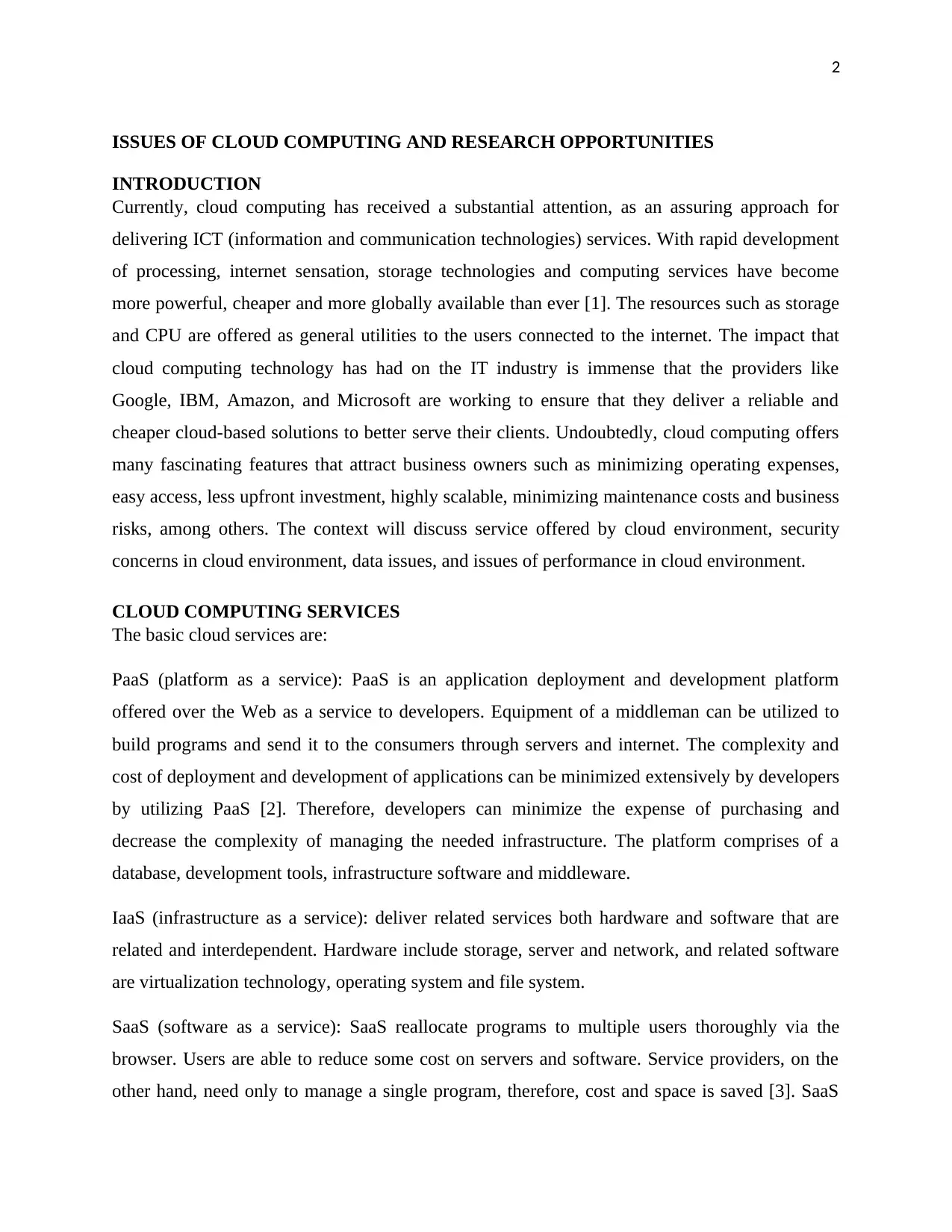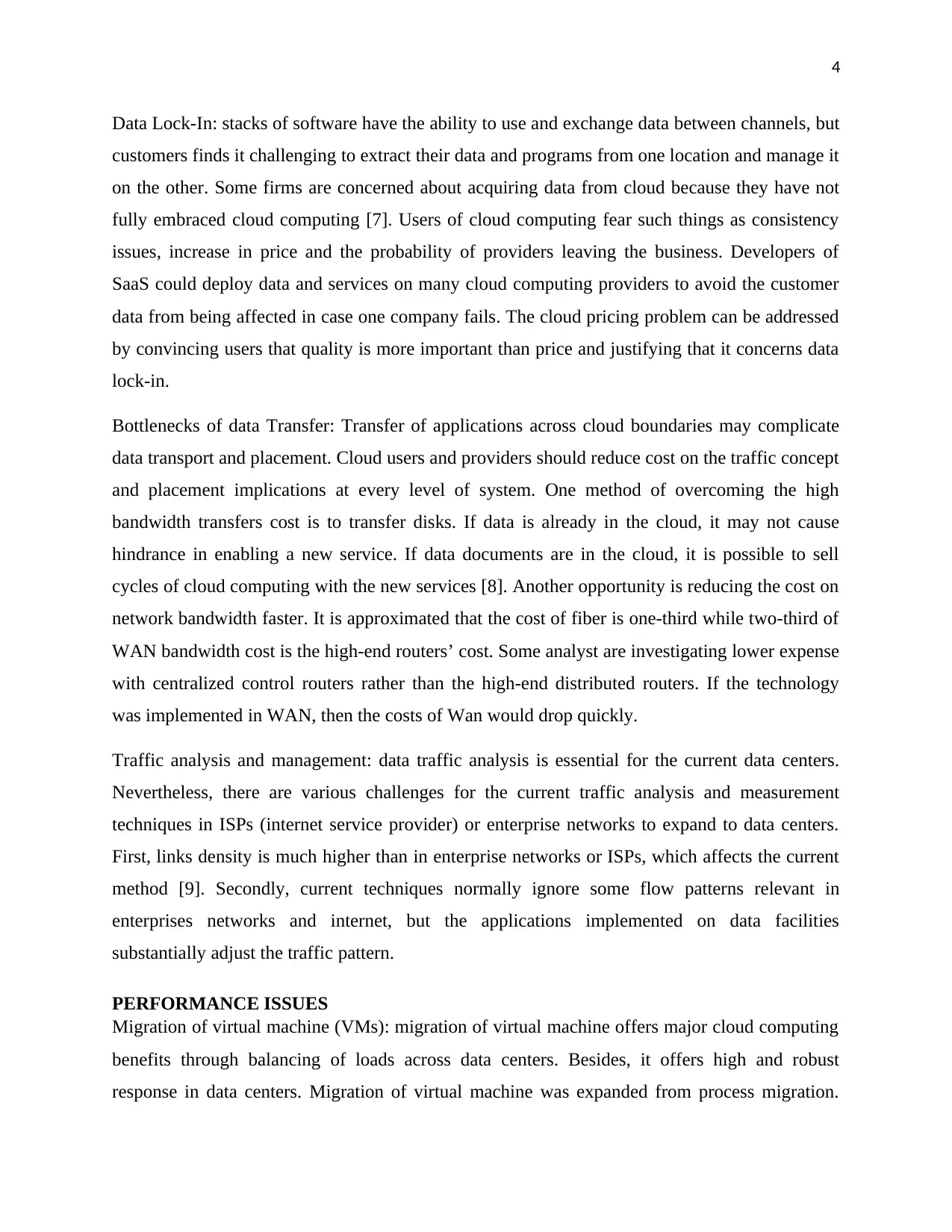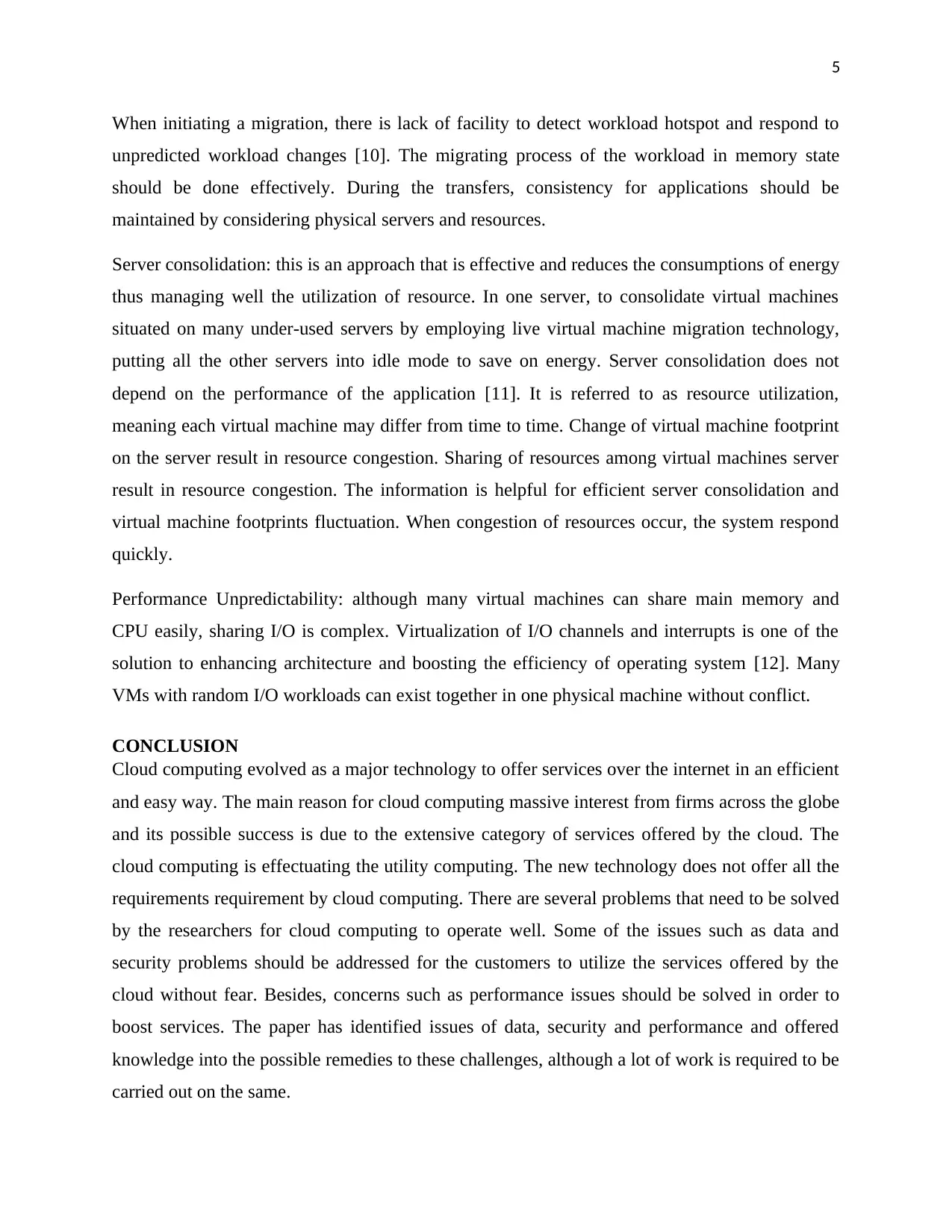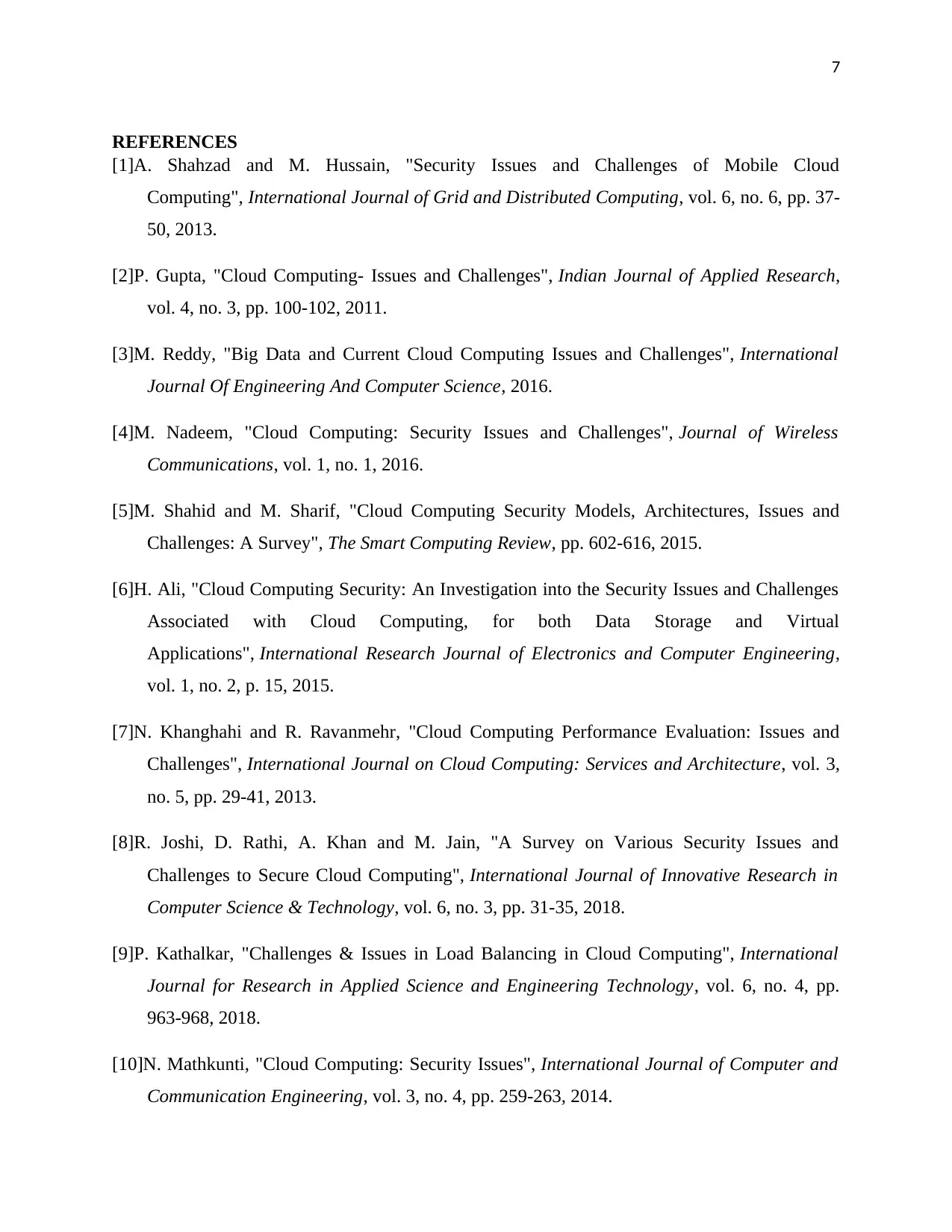MITS5002 Research Report: Cloud Computing Issues and Opportunities
VerifiedAdded on 2023/06/04
|8
|2180
|443
Report
AI Summary
This report provides an overview of cloud computing, highlighting its services (PaaS, IaaS, SaaS) and key issues related to security, data, and performance. Security concerns include service availability and data protection, while data issues encompass data lock-in and transfer bottlenecks. Performance challenges involve virtual machine migration, server consolidation, and unpredictability. The report explores potential remedies and research opportunities to address these challenges, emphasizing the need for robust solutions to ensure reliable and secure cloud services. This document is available on Desklib, a platform offering a wide array of study resources, including past papers and solved assignments, designed to support students in their academic pursuits.

1
ISSUES OF CLOUD COMPUTING AND RESEARCH OPPORTUNITIES
Student Name
Student ID
Instructor
Date
ISSUES OF CLOUD COMPUTING AND RESEARCH OPPORTUNITIES
Student Name
Student ID
Instructor
Date
Paraphrase This Document
Need a fresh take? Get an instant paraphrase of this document with our AI Paraphraser

2
ISSUES OF CLOUD COMPUTING AND RESEARCH OPPORTUNITIES
INTRODUCTION
Currently, cloud computing has received a substantial attention, as an assuring approach for
delivering ICT (information and communication technologies) services. With rapid development
of processing, internet sensation, storage technologies and computing services have become
more powerful, cheaper and more globally available than ever [1]. The resources such as storage
and CPU are offered as general utilities to the users connected to the internet. The impact that
cloud computing technology has had on the IT industry is immense that the providers like
Google, IBM, Amazon, and Microsoft are working to ensure that they deliver a reliable and
cheaper cloud-based solutions to better serve their clients. Undoubtedly, cloud computing offers
many fascinating features that attract business owners such as minimizing operating expenses,
easy access, less upfront investment, highly scalable, minimizing maintenance costs and business
risks, among others. The context will discuss service offered by cloud environment, security
concerns in cloud environment, data issues, and issues of performance in cloud environment.
CLOUD COMPUTING SERVICES
The basic cloud services are:
PaaS (platform as a service): PaaS is an application deployment and development platform
offered over the Web as a service to developers. Equipment of a middleman can be utilized to
build programs and send it to the consumers through servers and internet. The complexity and
cost of deployment and development of applications can be minimized extensively by developers
by utilizing PaaS [2]. Therefore, developers can minimize the expense of purchasing and
decrease the complexity of managing the needed infrastructure. The platform comprises of a
database, development tools, infrastructure software and middleware.
IaaS (infrastructure as a service): deliver related services both hardware and software that are
related and interdependent. Hardware include storage, server and network, and related software
are virtualization technology, operating system and file system.
SaaS (software as a service): SaaS reallocate programs to multiple users thoroughly via the
browser. Users are able to reduce some cost on servers and software. Service providers, on the
other hand, need only to manage a single program, therefore, cost and space is saved [3]. SaaS
ISSUES OF CLOUD COMPUTING AND RESEARCH OPPORTUNITIES
INTRODUCTION
Currently, cloud computing has received a substantial attention, as an assuring approach for
delivering ICT (information and communication technologies) services. With rapid development
of processing, internet sensation, storage technologies and computing services have become
more powerful, cheaper and more globally available than ever [1]. The resources such as storage
and CPU are offered as general utilities to the users connected to the internet. The impact that
cloud computing technology has had on the IT industry is immense that the providers like
Google, IBM, Amazon, and Microsoft are working to ensure that they deliver a reliable and
cheaper cloud-based solutions to better serve their clients. Undoubtedly, cloud computing offers
many fascinating features that attract business owners such as minimizing operating expenses,
easy access, less upfront investment, highly scalable, minimizing maintenance costs and business
risks, among others. The context will discuss service offered by cloud environment, security
concerns in cloud environment, data issues, and issues of performance in cloud environment.
CLOUD COMPUTING SERVICES
The basic cloud services are:
PaaS (platform as a service): PaaS is an application deployment and development platform
offered over the Web as a service to developers. Equipment of a middleman can be utilized to
build programs and send it to the consumers through servers and internet. The complexity and
cost of deployment and development of applications can be minimized extensively by developers
by utilizing PaaS [2]. Therefore, developers can minimize the expense of purchasing and
decrease the complexity of managing the needed infrastructure. The platform comprises of a
database, development tools, infrastructure software and middleware.
IaaS (infrastructure as a service): deliver related services both hardware and software that are
related and interdependent. Hardware include storage, server and network, and related software
are virtualization technology, operating system and file system.
SaaS (software as a service): SaaS reallocate programs to multiple users thoroughly via the
browser. Users are able to reduce some cost on servers and software. Service providers, on the
other hand, need only to manage a single program, therefore, cost and space is saved [3]. SaaS

3
provider naturally manages and host a particular application in their own and makes it available
to many users and tenants using the Web.
SECURITY ISSUES
The section reviews several security concerns in cloud environment.
Availability of service: considering that many firms are cautious of cloud computing and there
are adequate computing services, all available products of SaaS have a high standard. High
accessibility from cloud platforms is expected by users. It is very appealing for many customers
with business-continuity plan to migrate to cloud computing in vital situations [4]. They can
accept various firms to offer them independent software stacks, but it is not easy for one firm to
maintain, justify and develop more than one stack in pursuance of software dependability.
DDoS (Distributed Denial of Service) attack is another availability problem. Attackers utilize
large botnet to minimize the SaaS provider’s profits by rendering service unavailable. It is quite a
challenge to track and manage a botnet attack, but it can be easily identified if it lasts for a longer
time.
Data security: this is a critical opportunity for the cloud providers to research into because they
are not authorized to access physical data storage facilities. To acquire data security service
providers should rely in providers of the infrastructure [5]. The service provider can only point
out the specific security context in a virtual private cloud environment, and it is not clear how
those are fully deployed. During that time, the infrastructure must consider the following goals:
secure data transfer and access, application security interruption, auditability, and confidentiality.
Cryptographic tools are used to achieve the aspect of confidentiality while remote authentication
methods are used to attain auditability objective. Remote authentication usually needs a TPM
(trusted platform module) to create systems summary that are non-forgeable as the system
security proof. In virtual environment, virtual device can move from one location to another. It is
challenging to develop mechanism of trust in each structural cloud layer [6]. Migration of virtual
machine should only occur if both the destination and source servers are dependable.
DATA ISSUES
The section discusses of issues of data in cloud environment.
provider naturally manages and host a particular application in their own and makes it available
to many users and tenants using the Web.
SECURITY ISSUES
The section reviews several security concerns in cloud environment.
Availability of service: considering that many firms are cautious of cloud computing and there
are adequate computing services, all available products of SaaS have a high standard. High
accessibility from cloud platforms is expected by users. It is very appealing for many customers
with business-continuity plan to migrate to cloud computing in vital situations [4]. They can
accept various firms to offer them independent software stacks, but it is not easy for one firm to
maintain, justify and develop more than one stack in pursuance of software dependability.
DDoS (Distributed Denial of Service) attack is another availability problem. Attackers utilize
large botnet to minimize the SaaS provider’s profits by rendering service unavailable. It is quite a
challenge to track and manage a botnet attack, but it can be easily identified if it lasts for a longer
time.
Data security: this is a critical opportunity for the cloud providers to research into because they
are not authorized to access physical data storage facilities. To acquire data security service
providers should rely in providers of the infrastructure [5]. The service provider can only point
out the specific security context in a virtual private cloud environment, and it is not clear how
those are fully deployed. During that time, the infrastructure must consider the following goals:
secure data transfer and access, application security interruption, auditability, and confidentiality.
Cryptographic tools are used to achieve the aspect of confidentiality while remote authentication
methods are used to attain auditability objective. Remote authentication usually needs a TPM
(trusted platform module) to create systems summary that are non-forgeable as the system
security proof. In virtual environment, virtual device can move from one location to another. It is
challenging to develop mechanism of trust in each structural cloud layer [6]. Migration of virtual
machine should only occur if both the destination and source servers are dependable.
DATA ISSUES
The section discusses of issues of data in cloud environment.
⊘ This is a preview!⊘
Do you want full access?
Subscribe today to unlock all pages.

Trusted by 1+ million students worldwide

4
Data Lock-In: stacks of software have the ability to use and exchange data between channels, but
customers finds it challenging to extract their data and programs from one location and manage it
on the other. Some firms are concerned about acquiring data from cloud because they have not
fully embraced cloud computing [7]. Users of cloud computing fear such things as consistency
issues, increase in price and the probability of providers leaving the business. Developers of
SaaS could deploy data and services on many cloud computing providers to avoid the customer
data from being affected in case one company fails. The cloud pricing problem can be addressed
by convincing users that quality is more important than price and justifying that it concerns data
lock-in.
Bottlenecks of data Transfer: Transfer of applications across cloud boundaries may complicate
data transport and placement. Cloud users and providers should reduce cost on the traffic concept
and placement implications at every level of system. One method of overcoming the high
bandwidth transfers cost is to transfer disks. If data is already in the cloud, it may not cause
hindrance in enabling a new service. If data documents are in the cloud, it is possible to sell
cycles of cloud computing with the new services [8]. Another opportunity is reducing the cost on
network bandwidth faster. It is approximated that the cost of fiber is one-third while two-third of
WAN bandwidth cost is the high-end routers’ cost. Some analyst are investigating lower expense
with centralized control routers rather than the high-end distributed routers. If the technology
was implemented in WAN, then the costs of Wan would drop quickly.
Traffic analysis and management: data traffic analysis is essential for the current data centers.
Nevertheless, there are various challenges for the current traffic analysis and measurement
techniques in ISPs (internet service provider) or enterprise networks to expand to data centers.
First, links density is much higher than in enterprise networks or ISPs, which affects the current
method [9]. Secondly, current techniques normally ignore some flow patterns relevant in
enterprises networks and internet, but the applications implemented on data facilities
substantially adjust the traffic pattern.
PERFORMANCE ISSUES
Migration of virtual machine (VMs): migration of virtual machine offers major cloud computing
benefits through balancing of loads across data centers. Besides, it offers high and robust
response in data centers. Migration of virtual machine was expanded from process migration.
Data Lock-In: stacks of software have the ability to use and exchange data between channels, but
customers finds it challenging to extract their data and programs from one location and manage it
on the other. Some firms are concerned about acquiring data from cloud because they have not
fully embraced cloud computing [7]. Users of cloud computing fear such things as consistency
issues, increase in price and the probability of providers leaving the business. Developers of
SaaS could deploy data and services on many cloud computing providers to avoid the customer
data from being affected in case one company fails. The cloud pricing problem can be addressed
by convincing users that quality is more important than price and justifying that it concerns data
lock-in.
Bottlenecks of data Transfer: Transfer of applications across cloud boundaries may complicate
data transport and placement. Cloud users and providers should reduce cost on the traffic concept
and placement implications at every level of system. One method of overcoming the high
bandwidth transfers cost is to transfer disks. If data is already in the cloud, it may not cause
hindrance in enabling a new service. If data documents are in the cloud, it is possible to sell
cycles of cloud computing with the new services [8]. Another opportunity is reducing the cost on
network bandwidth faster. It is approximated that the cost of fiber is one-third while two-third of
WAN bandwidth cost is the high-end routers’ cost. Some analyst are investigating lower expense
with centralized control routers rather than the high-end distributed routers. If the technology
was implemented in WAN, then the costs of Wan would drop quickly.
Traffic analysis and management: data traffic analysis is essential for the current data centers.
Nevertheless, there are various challenges for the current traffic analysis and measurement
techniques in ISPs (internet service provider) or enterprise networks to expand to data centers.
First, links density is much higher than in enterprise networks or ISPs, which affects the current
method [9]. Secondly, current techniques normally ignore some flow patterns relevant in
enterprises networks and internet, but the applications implemented on data facilities
substantially adjust the traffic pattern.
PERFORMANCE ISSUES
Migration of virtual machine (VMs): migration of virtual machine offers major cloud computing
benefits through balancing of loads across data centers. Besides, it offers high and robust
response in data centers. Migration of virtual machine was expanded from process migration.
Paraphrase This Document
Need a fresh take? Get an instant paraphrase of this document with our AI Paraphraser

5
When initiating a migration, there is lack of facility to detect workload hotspot and respond to
unpredicted workload changes [10]. The migrating process of the workload in memory state
should be done effectively. During the transfers, consistency for applications should be
maintained by considering physical servers and resources.
Server consolidation: this is an approach that is effective and reduces the consumptions of energy
thus managing well the utilization of resource. In one server, to consolidate virtual machines
situated on many under-used servers by employing live virtual machine migration technology,
putting all the other servers into idle mode to save on energy. Server consolidation does not
depend on the performance of the application [11]. It is referred to as resource utilization,
meaning each virtual machine may differ from time to time. Change of virtual machine footprint
on the server result in resource congestion. Sharing of resources among virtual machines server
result in resource congestion. The information is helpful for efficient server consolidation and
virtual machine footprints fluctuation. When congestion of resources occur, the system respond
quickly.
Performance Unpredictability: although many virtual machines can share main memory and
CPU easily, sharing I/O is complex. Virtualization of I/O channels and interrupts is one of the
solution to enhancing architecture and boosting the efficiency of operating system [12]. Many
VMs with random I/O workloads can exist together in one physical machine without conflict.
CONCLUSION
Cloud computing evolved as a major technology to offer services over the internet in an efficient
and easy way. The main reason for cloud computing massive interest from firms across the globe
and its possible success is due to the extensive category of services offered by the cloud. The
cloud computing is effectuating the utility computing. The new technology does not offer all the
requirements requirement by cloud computing. There are several problems that need to be solved
by the researchers for cloud computing to operate well. Some of the issues such as data and
security problems should be addressed for the customers to utilize the services offered by the
cloud without fear. Besides, concerns such as performance issues should be solved in order to
boost services. The paper has identified issues of data, security and performance and offered
knowledge into the possible remedies to these challenges, although a lot of work is required to be
carried out on the same.
When initiating a migration, there is lack of facility to detect workload hotspot and respond to
unpredicted workload changes [10]. The migrating process of the workload in memory state
should be done effectively. During the transfers, consistency for applications should be
maintained by considering physical servers and resources.
Server consolidation: this is an approach that is effective and reduces the consumptions of energy
thus managing well the utilization of resource. In one server, to consolidate virtual machines
situated on many under-used servers by employing live virtual machine migration technology,
putting all the other servers into idle mode to save on energy. Server consolidation does not
depend on the performance of the application [11]. It is referred to as resource utilization,
meaning each virtual machine may differ from time to time. Change of virtual machine footprint
on the server result in resource congestion. Sharing of resources among virtual machines server
result in resource congestion. The information is helpful for efficient server consolidation and
virtual machine footprints fluctuation. When congestion of resources occur, the system respond
quickly.
Performance Unpredictability: although many virtual machines can share main memory and
CPU easily, sharing I/O is complex. Virtualization of I/O channels and interrupts is one of the
solution to enhancing architecture and boosting the efficiency of operating system [12]. Many
VMs with random I/O workloads can exist together in one physical machine without conflict.
CONCLUSION
Cloud computing evolved as a major technology to offer services over the internet in an efficient
and easy way. The main reason for cloud computing massive interest from firms across the globe
and its possible success is due to the extensive category of services offered by the cloud. The
cloud computing is effectuating the utility computing. The new technology does not offer all the
requirements requirement by cloud computing. There are several problems that need to be solved
by the researchers for cloud computing to operate well. Some of the issues such as data and
security problems should be addressed for the customers to utilize the services offered by the
cloud without fear. Besides, concerns such as performance issues should be solved in order to
boost services. The paper has identified issues of data, security and performance and offered
knowledge into the possible remedies to these challenges, although a lot of work is required to be
carried out on the same.

6
⊘ This is a preview!⊘
Do you want full access?
Subscribe today to unlock all pages.

Trusted by 1+ million students worldwide

7
REFERENCES
[1]A. Shahzad and M. Hussain, "Security Issues and Challenges of Mobile Cloud
Computing", International Journal of Grid and Distributed Computing, vol. 6, no. 6, pp. 37-
50, 2013.
[2]P. Gupta, "Cloud Computing- Issues and Challenges", Indian Journal of Applied Research,
vol. 4, no. 3, pp. 100-102, 2011.
[3]M. Reddy, "Big Data and Current Cloud Computing Issues and Challenges", International
Journal Of Engineering And Computer Science, 2016.
[4]M. Nadeem, "Cloud Computing: Security Issues and Challenges", Journal of Wireless
Communications, vol. 1, no. 1, 2016.
[5]M. Shahid and M. Sharif, "Cloud Computing Security Models, Architectures, Issues and
Challenges: A Survey", The Smart Computing Review, pp. 602-616, 2015.
[6]H. Ali, "Cloud Computing Security: An Investigation into the Security Issues and Challenges
Associated with Cloud Computing, for both Data Storage and Virtual
Applications", International Research Journal of Electronics and Computer Engineering,
vol. 1, no. 2, p. 15, 2015.
[7]N. Khanghahi and R. Ravanmehr, "Cloud Computing Performance Evaluation: Issues and
Challenges", International Journal on Cloud Computing: Services and Architecture, vol. 3,
no. 5, pp. 29-41, 2013.
[8]R. Joshi, D. Rathi, A. Khan and M. Jain, "A Survey on Various Security Issues and
Challenges to Secure Cloud Computing", International Journal of Innovative Research in
Computer Science & Technology, vol. 6, no. 3, pp. 31-35, 2018.
[9]P. Kathalkar, "Challenges & Issues in Load Balancing in Cloud Computing", International
Journal for Research in Applied Science and Engineering Technology, vol. 6, no. 4, pp.
963-968, 2018.
[10]N. Mathkunti, "Cloud Computing: Security Issues", International Journal of Computer and
Communication Engineering, vol. 3, no. 4, pp. 259-263, 2014.
REFERENCES
[1]A. Shahzad and M. Hussain, "Security Issues and Challenges of Mobile Cloud
Computing", International Journal of Grid and Distributed Computing, vol. 6, no. 6, pp. 37-
50, 2013.
[2]P. Gupta, "Cloud Computing- Issues and Challenges", Indian Journal of Applied Research,
vol. 4, no. 3, pp. 100-102, 2011.
[3]M. Reddy, "Big Data and Current Cloud Computing Issues and Challenges", International
Journal Of Engineering And Computer Science, 2016.
[4]M. Nadeem, "Cloud Computing: Security Issues and Challenges", Journal of Wireless
Communications, vol. 1, no. 1, 2016.
[5]M. Shahid and M. Sharif, "Cloud Computing Security Models, Architectures, Issues and
Challenges: A Survey", The Smart Computing Review, pp. 602-616, 2015.
[6]H. Ali, "Cloud Computing Security: An Investigation into the Security Issues and Challenges
Associated with Cloud Computing, for both Data Storage and Virtual
Applications", International Research Journal of Electronics and Computer Engineering,
vol. 1, no. 2, p. 15, 2015.
[7]N. Khanghahi and R. Ravanmehr, "Cloud Computing Performance Evaluation: Issues and
Challenges", International Journal on Cloud Computing: Services and Architecture, vol. 3,
no. 5, pp. 29-41, 2013.
[8]R. Joshi, D. Rathi, A. Khan and M. Jain, "A Survey on Various Security Issues and
Challenges to Secure Cloud Computing", International Journal of Innovative Research in
Computer Science & Technology, vol. 6, no. 3, pp. 31-35, 2018.
[9]P. Kathalkar, "Challenges & Issues in Load Balancing in Cloud Computing", International
Journal for Research in Applied Science and Engineering Technology, vol. 6, no. 4, pp.
963-968, 2018.
[10]N. Mathkunti, "Cloud Computing: Security Issues", International Journal of Computer and
Communication Engineering, vol. 3, no. 4, pp. 259-263, 2014.
Paraphrase This Document
Need a fresh take? Get an instant paraphrase of this document with our AI Paraphraser

8
[11]J. Martin-Flatin, "Challenges in Cloud Management", IEEE Cloud Computing, vol. 1, no. 1,
pp. 66-70, 2014.
[12]S. Singh and I. Chana, "A Survey on Resource Scheduling in Cloud Computing: Issues and
Challenges", Journal of Grid Computing, vol. 14, no. 2, pp. 217-264, 2016.
[11]J. Martin-Flatin, "Challenges in Cloud Management", IEEE Cloud Computing, vol. 1, no. 1,
pp. 66-70, 2014.
[12]S. Singh and I. Chana, "A Survey on Resource Scheduling in Cloud Computing: Issues and
Challenges", Journal of Grid Computing, vol. 14, no. 2, pp. 217-264, 2016.
1 out of 8
Related Documents
Your All-in-One AI-Powered Toolkit for Academic Success.
+13062052269
info@desklib.com
Available 24*7 on WhatsApp / Email
![[object Object]](/_next/static/media/star-bottom.7253800d.svg)
Unlock your academic potential
Copyright © 2020–2025 A2Z Services. All Rights Reserved. Developed and managed by ZUCOL.




